JEEP PATRIOT 2007 1.G Manual PDF
Manufacturer: JEEP, Model Year: 2007, Model line: PATRIOT, Model: JEEP PATRIOT 2007 1.GPages: 440, PDF Size: 7.26 MB
Page 71 of 440
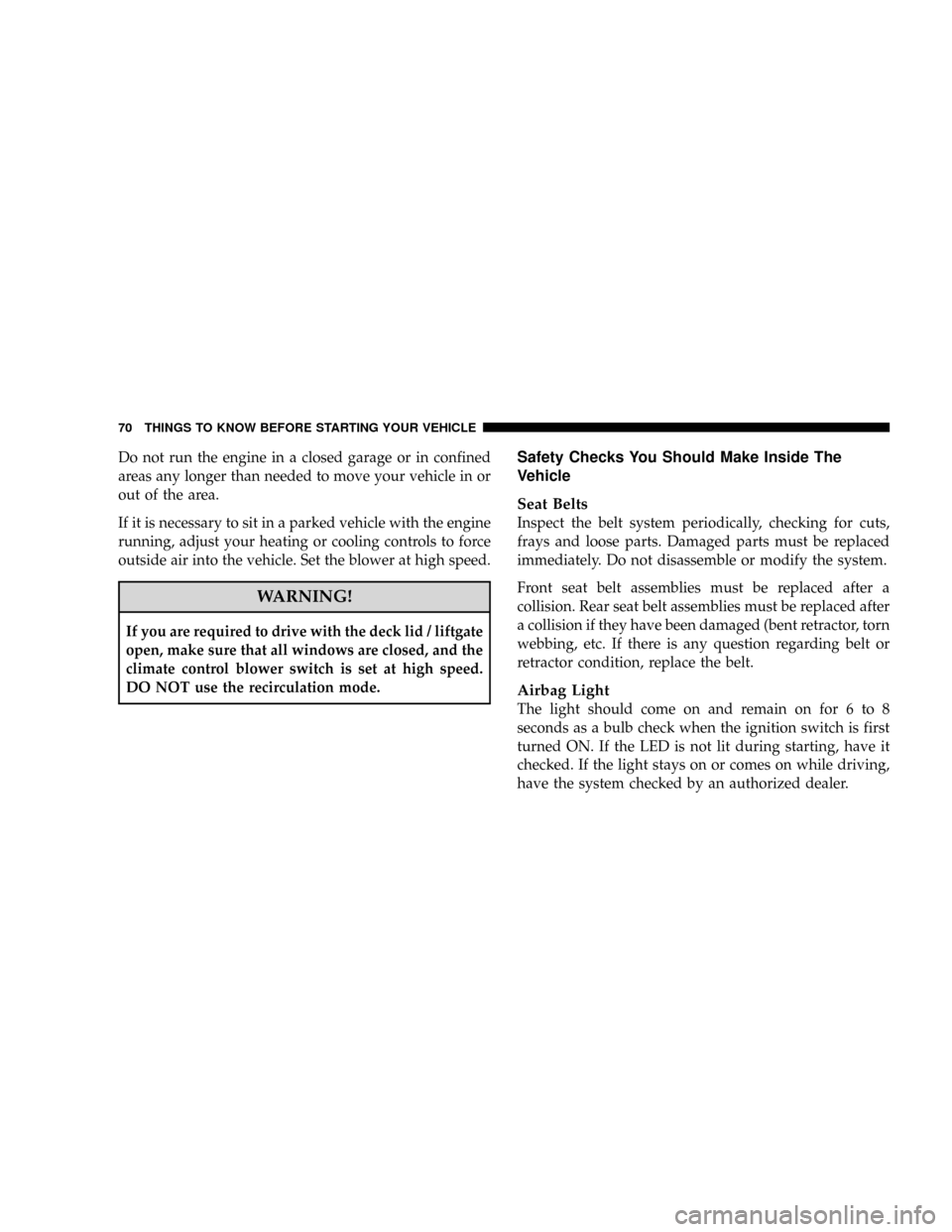
Do not run the engine in a closed garage or in confined
areas any longer than needed to move your vehicle in or
out of the area.
If it is necessary to sit in a parked vehicle with the engine
running, adjust your heating or cooling controls to force
outside air into the vehicle. Set the blower at high speed.
WARNING!
If you are required to drive with the deck lid / liftgate
open, make sure that all windows are closed, and the
climate control blower switch is set at high speed.
DO NOT use the recirculation mode.
Safety Checks You Should Make Inside The
Vehicle
Seat Belts
Inspect the belt system periodically, checking for cuts,
frays and loose parts. Damaged parts must be replaced
immediately. Do not disassemble or modify the system.
Front seat belt assemblies must be replaced after a
collision. Rear seat belt assemblies must be replaced after
a collision if they have been damaged (bent retractor, torn
webbing, etc. If there is any question regarding belt or
retractor condition, replace the belt.
Airbag Light
The light should come on and remain on for 6 to 8
seconds as a bulb check when the ignition switch is first
turned ON. If the LED is not lit during starting, have it
checked. If the light stays on or comes on while driving,
have the system checked by an authorized dealer.
70 THINGS TO KNOW BEFORE STARTING YOUR VEHICLE
Page 72 of 440
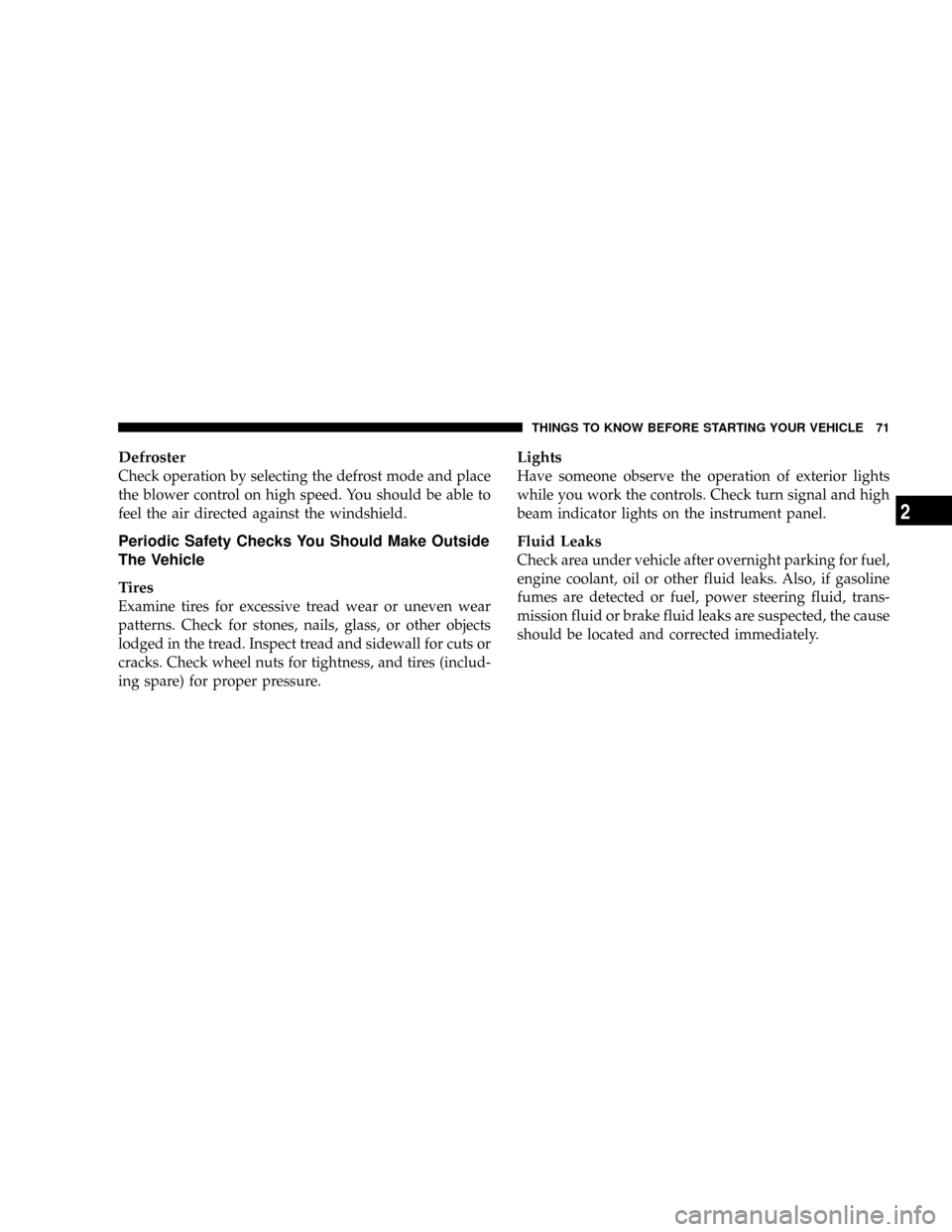
Defroster
Check operation by selecting the defrost mode and place
the blower control on high speed. You should be able to
feel the air directed against the windshield.
Periodic Safety Checks You Should Make Outside
The Vehicle
Tires
Examine tires for excessive tread wear or uneven wear
patterns. Check for stones, nails, glass, or other objects
lodged in the tread. Inspect tread and sidewall for cuts or
cracks. Check wheel nuts for tightness, and tires (includ-
ing spare) for proper pressure.
Lights
Have someone observe the operation of exterior lights
while you work the controls. Check turn signal and high
beam indicator lights on the instrument panel.
Fluid Leaks
Check area under vehicle after overnight parking for fuel,
engine coolant, oil or other fluid leaks. Also, if gasoline
fumes are detected or fuel, power steering fluid, trans-
mission fluid or brake fluid leaks are suspected, the cause
should be located and corrected immediately.
THINGS TO KNOW BEFORE STARTING YOUR VEHICLE 71
2
Page 73 of 440

Page 74 of 440
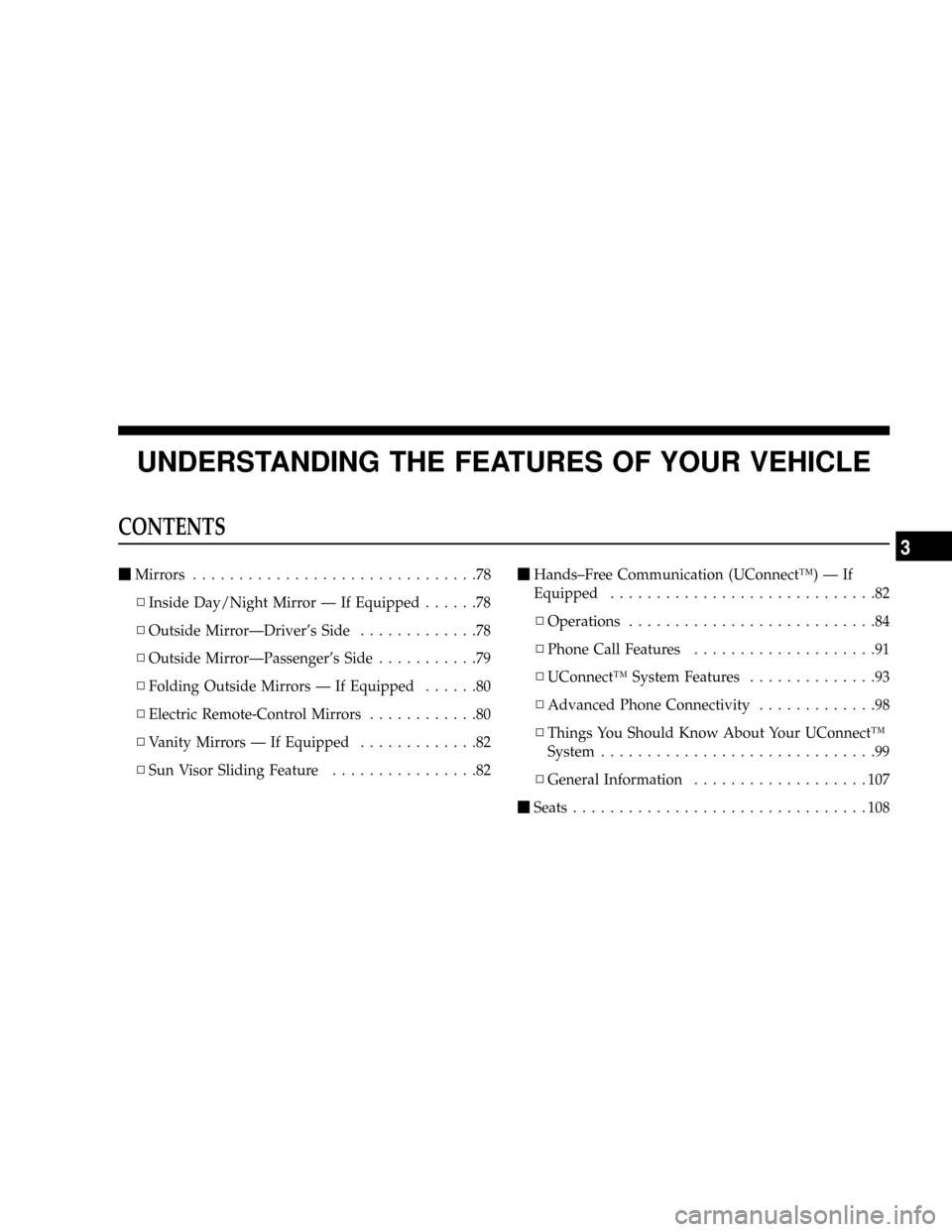
UNDERSTANDING THE FEATURES OF YOUR VEHICLE
CONTENTS
mMirrors...............................78
NInside Day/Night Mirror Ð If Equipped......78
NOutside MirrorÐDriver's Side.............78
NOutside MirrorÐPassenger's Side...........79
NFolding Outside Mirrors Ð If Equipped......80
NElectric Remote-Control Mirrors............80
NVanity Mirrors Ð If Equipped.............82
NSun Visor Sliding Feature................82mHands±Free Communication (UConnectŸ) Ð If
Equipped.............................82
NOperations...........................84
NPhone Call Features....................91
NUConnectŸ System Features..............93
NAdvanced Phone Connectivity.............98
NThings You Should Know About Your UConnectŸ
System..............................99
NGeneral Information...................107
mSeats................................108
3
Page 75 of 440
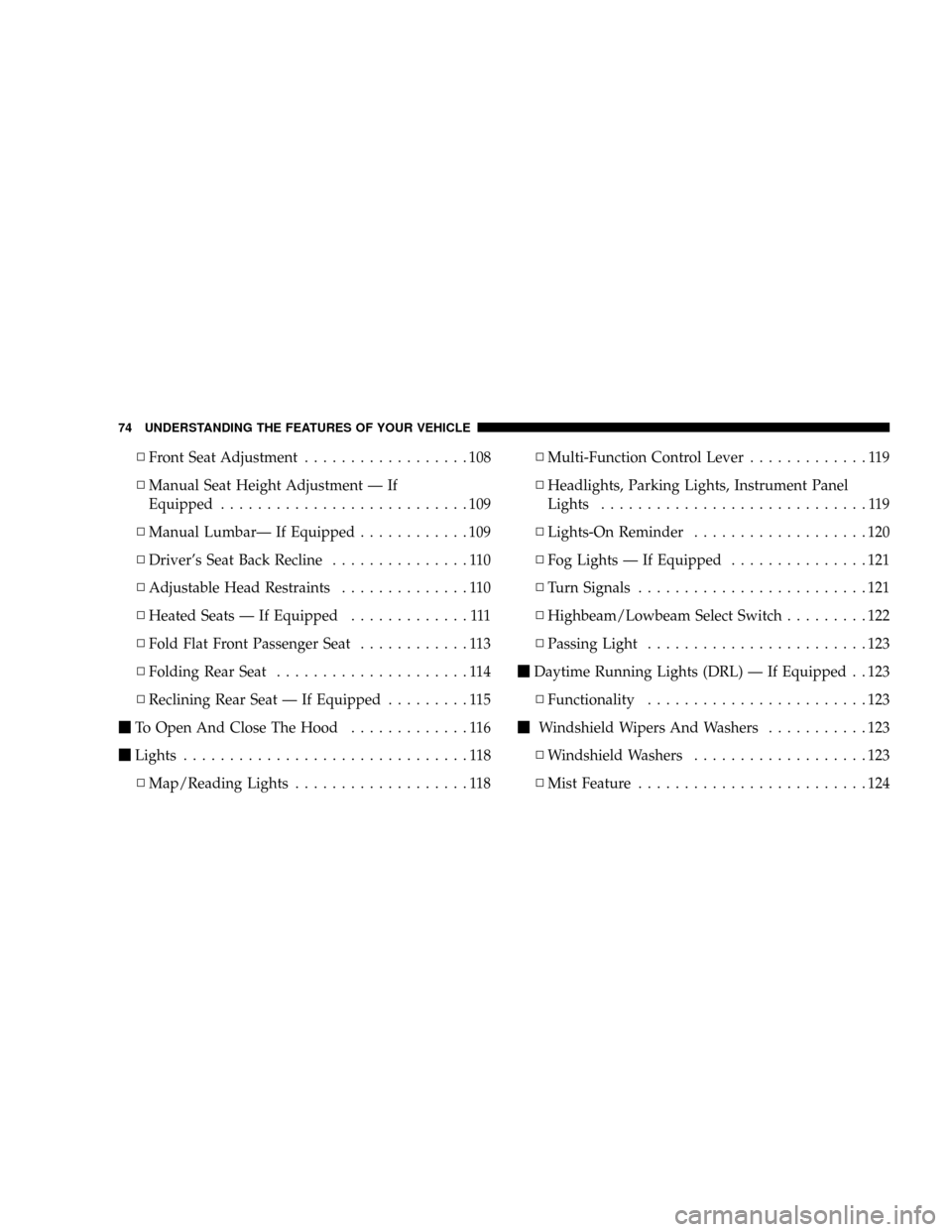
NFront Seat Adjustment..................108
NManual Seat Height Adjustment Ð If
Equipped...........................109
NManual LumbarÐ If Equipped............109
NDriver's Seat Back Recline...............110
NAdjustable Head Restraints..............110
NHeated Seats Ð If Equipped.............111
NFold Flat Front Passenger Seat............113
NFolding Rear Seat.....................114
NReclining Rear Seat Ð If Equipped.........115
mTo Open And Close The Hood.............116
mLights...............................118
NMap/Reading Lights...................118NMulti-Function Control Lever.............119
NHeadlights, Parking Lights, Instrument Panel
Lights.............................119
NLights-On Reminder...................120
NFog Lights Ð If Equipped...............121
NTurn Signals.........................121
NHighbeam/Lowbeam Select Switch.........122
NPassing Light........................123
mDaytime Running Lights (DRL) Ð If Equipped . . 123
NFunctionality........................123
mWindshield Wipers And Washers...........123
NWindshield Washers...................123
NMist Feature.........................124
74 UNDERSTANDING THE FEATURES OF YOUR VEHICLE
Page 76 of 440
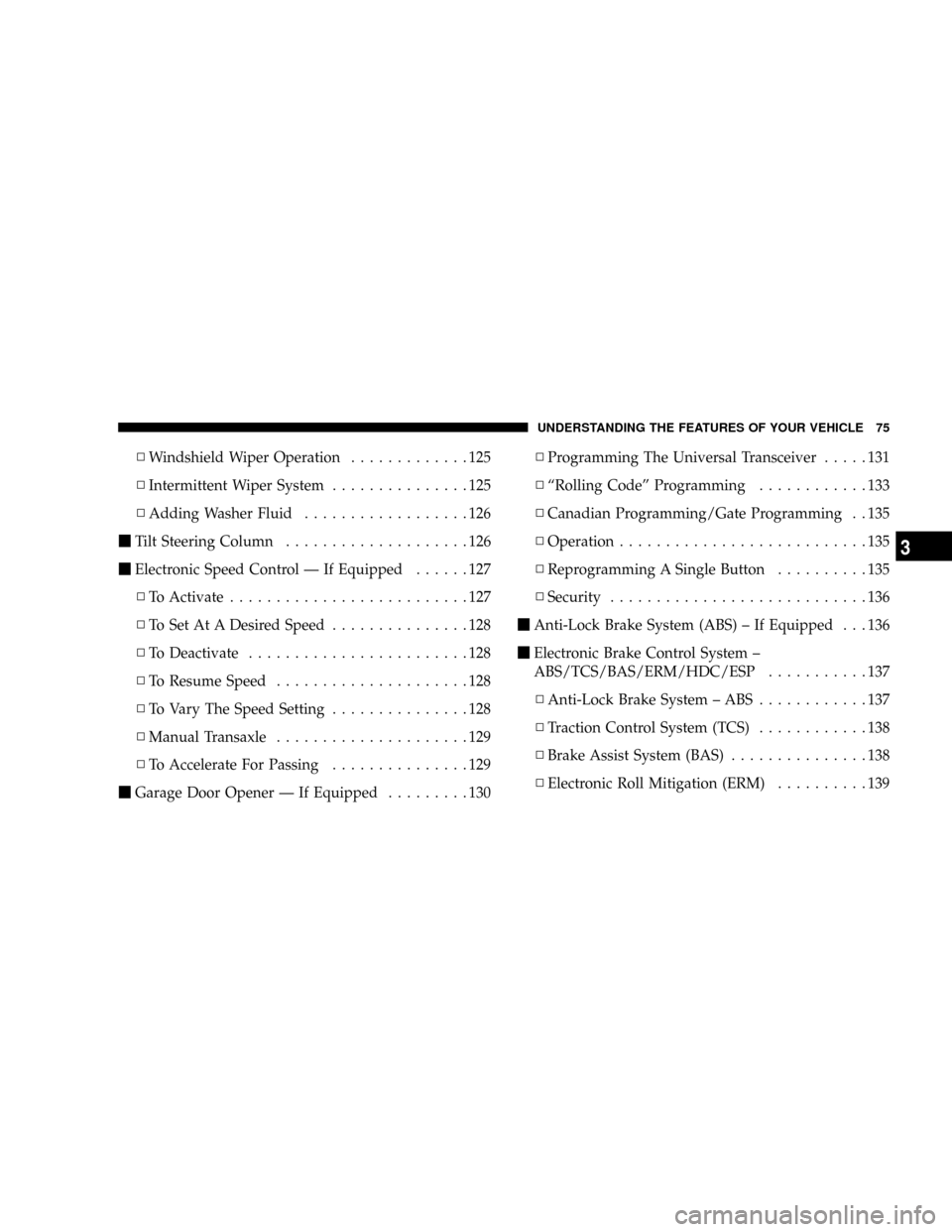
NWindshield Wiper Operation.............125
NIntermittent Wiper System...............125
NAdding Washer Fluid..................126
mTilt Steering Column....................126
mElectronic Speed Control Ð If Equipped......127
NTo Activate..........................127
NTo Set At A Desired Speed...............128
NTo Deactivate........................128
NTo Resume Speed.....................128
NTo Vary The Speed Setting...............128
NManual Transaxle.....................129
NTo Accelerate For Passing...............129
mGarage Door Opener Ð If Equipped.........130NProgramming The Universal Transceiver.....131
NªRolling Codeº Programming............133
NCanadian Programming/Gate Programming . . 135
NOperation...........................135
NReprogramming A Single Button..........135
NSecurity............................136
mAnti-Lock Brake System (ABS) ± If Equipped . . . 136
mElectronic Brake Control System ±
ABS/TCS/BAS/ERM/HDC/ESP...........137
NAnti-Lock Brake System ± ABS............137
NTraction Control System (TCS)............138
NBrake Assist System (BAS)...............138
NElectronic Roll Mitigation (ERM)..........139
UNDERSTANDING THE FEATURES OF YOUR VEHICLE 75
3
Page 77 of 440
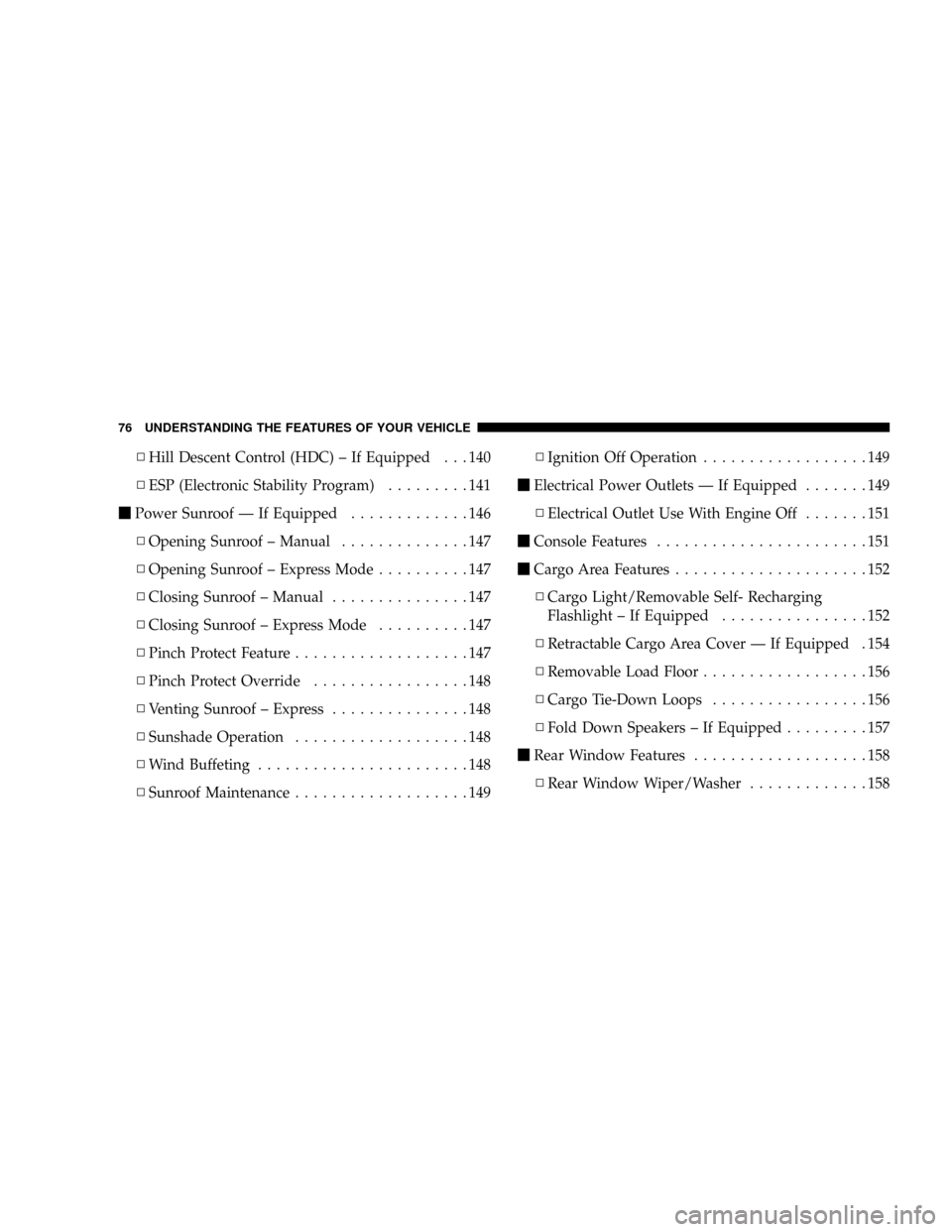
NHill Descent Control (HDC) ± If Equipped . . . 140
NESP (Electronic Stability Program).........141
mPower Sunroof Ð If Equipped.............146
NOpening Sunroof ± Manual..............147
NOpening Sunroof ± Express Mode..........147
NClosing Sunroof ± Manual...............147
NClosing Sunroof ± Express Mode..........147
NPinch Protect Feature...................147
NPinch Protect Override.................148
NVenting Sunroof ± Express...............148
NSunshade Operation...................148
NWind Buffeting.......................148
NSunroof Maintenance...................149NIgnition Off Operation..................149
mElectrical Power Outlets Ð If Equipped.......149
NElectrical Outlet Use With Engine Off.......151
mConsole Features.......................151
mCargo Area Features.....................152
NCargo Light/Removable Self- Recharging
Flashlight ± If Equipped................152
NRetractable Cargo Area Cover Ð If Equipped . 154
NRemovable Load Floor..................156
NCargo Tie-Down Loops.................156
NFold Down Speakers ± If Equipped.........157
mRear Window Features...................158
NRear Window Wiper/Washer.............158
76 UNDERSTANDING THE FEATURES OF YOUR VEHICLE
Page 78 of 440
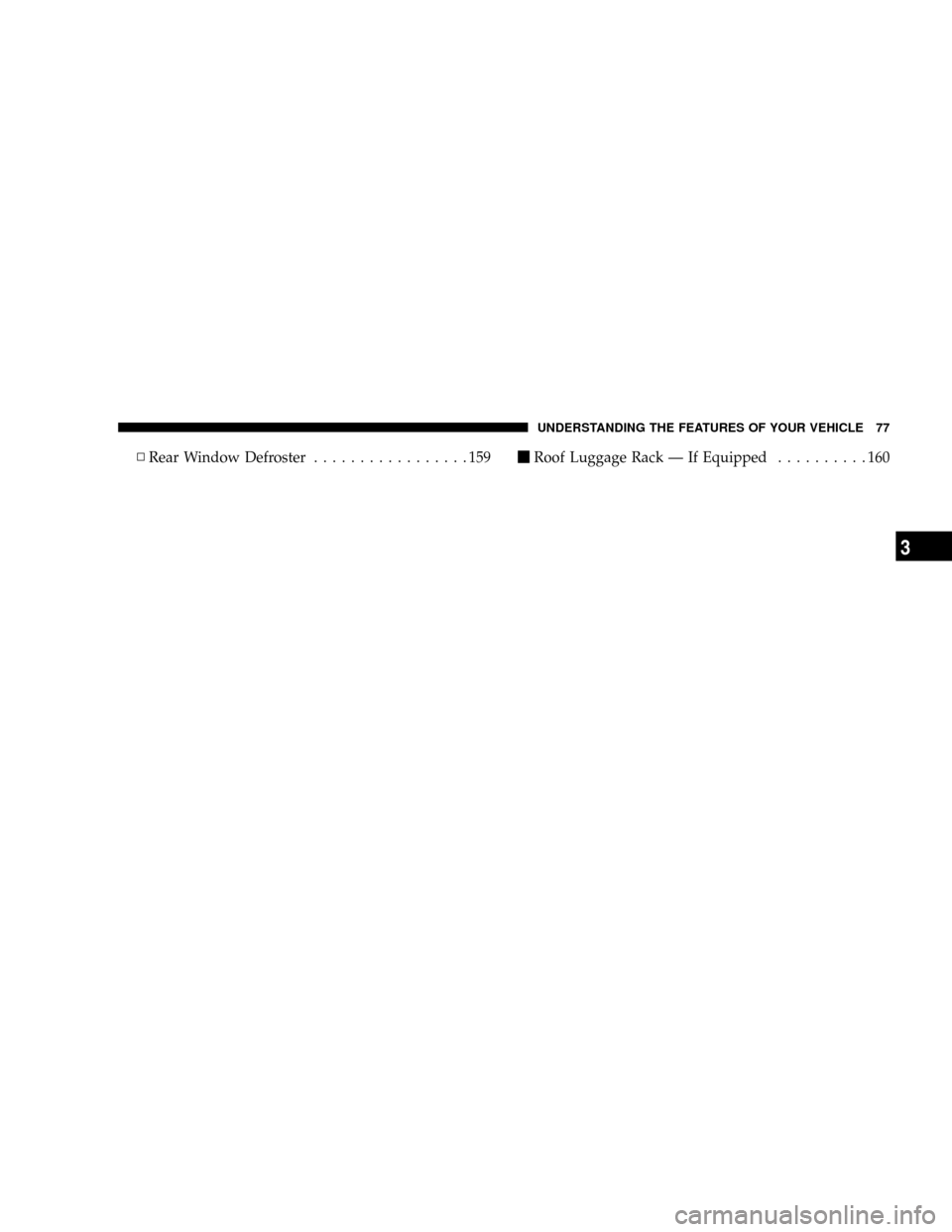
NRear Window Defroster.................159mRoof Luggage Rack Ð If Equipped..........160
UNDERSTANDING THE FEATURES OF YOUR VEHICLE 77
3
Page 79 of 440
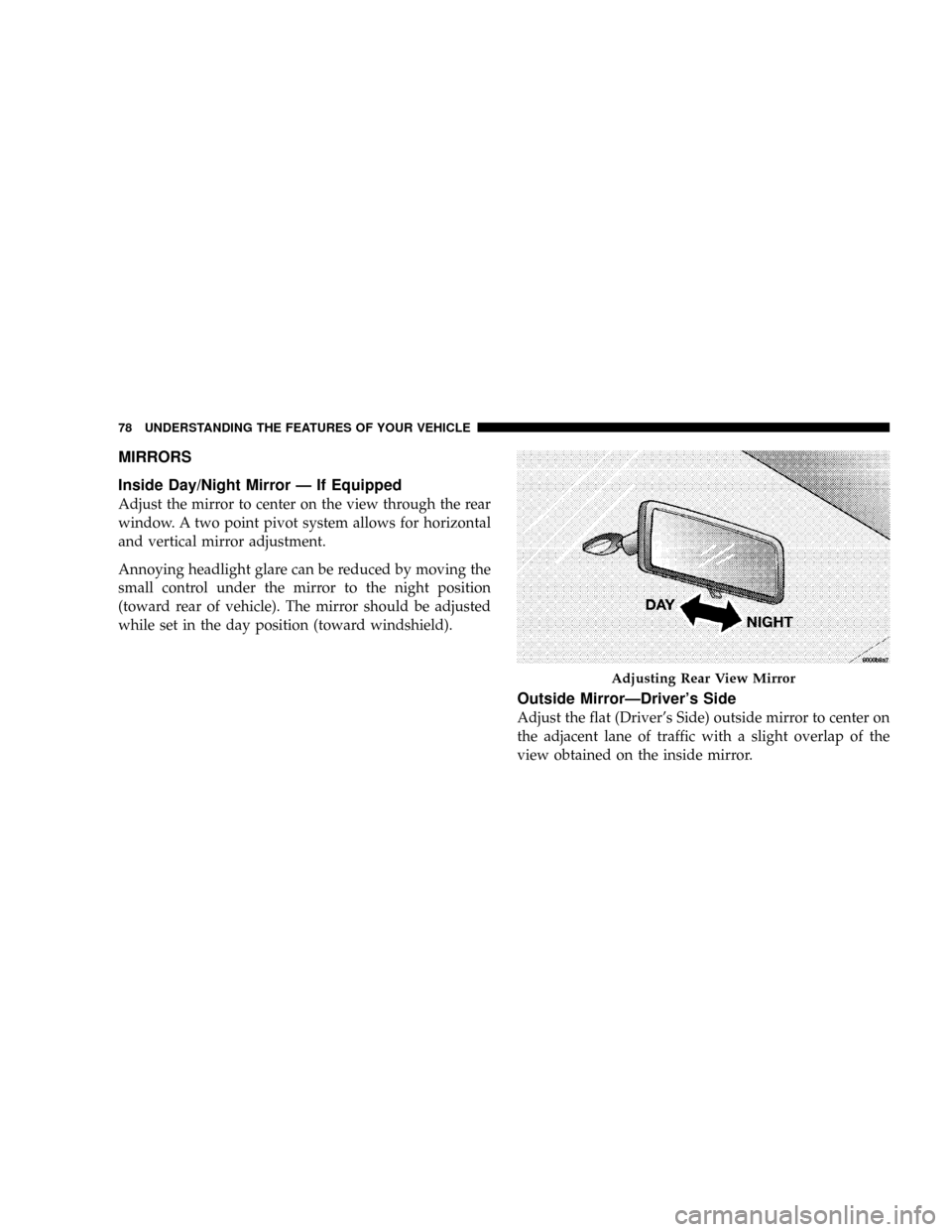
MIRRORS
Inside Day/Night Mirror Ð If Equipped
Adjust the mirror to center on the view through the rear
window. A two point pivot system allows for horizontal
and vertical mirror adjustment.
Annoying headlight glare can be reduced by moving the
small control under the mirror to the night position
(toward rear of vehicle). The mirror should be adjusted
while set in the day position (toward windshield).
Outside MirrorÐDriver's Side
Adjust the flat (Driver's Side) outside mirror to center on
the adjacent lane of traffic with a slight overlap of the
view obtained on the inside mirror.
Adjusting Rear View Mirror
78 UNDERSTANDING THE FEATURES OF YOUR VEHICLE
Page 80 of 440
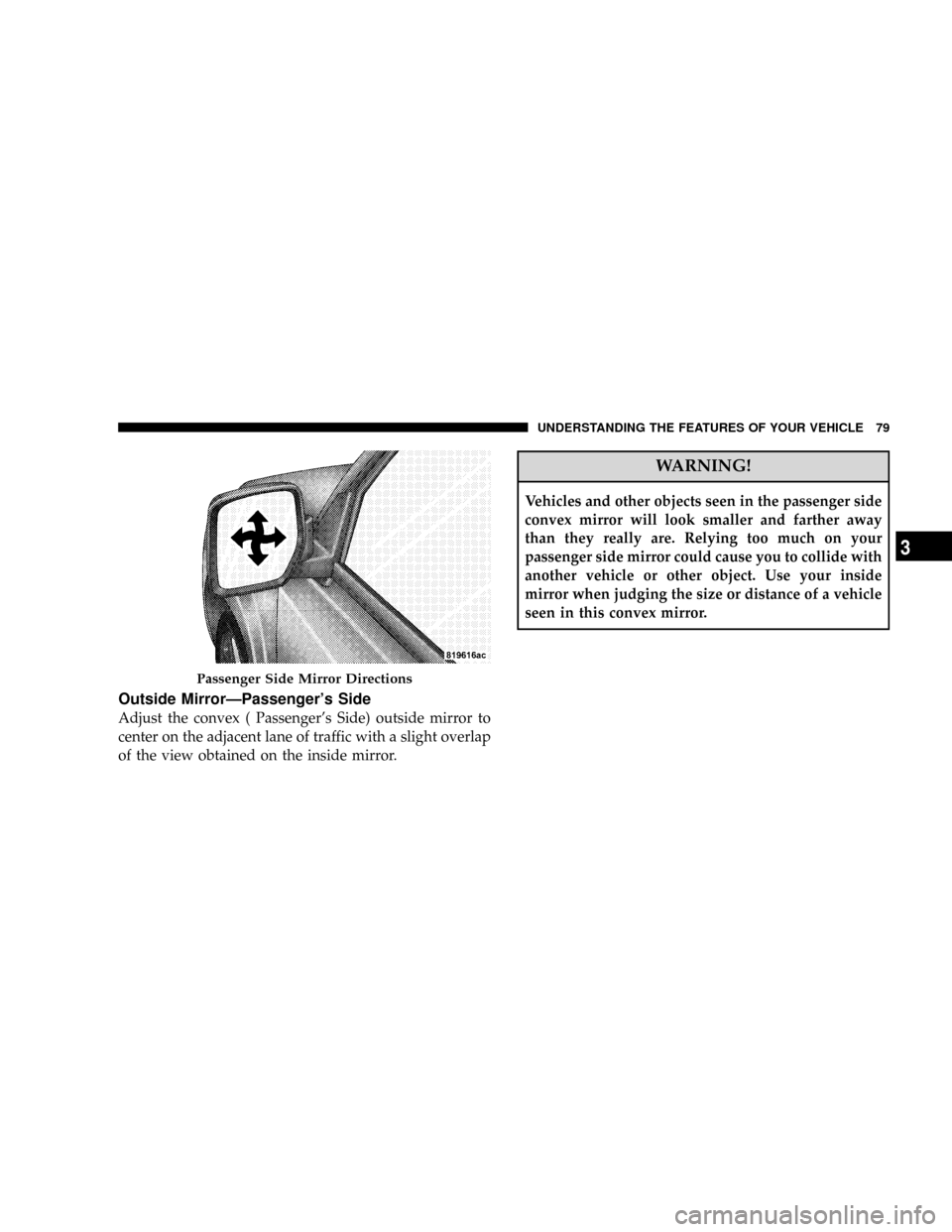
Outside MirrorÐPassenger's Side
Adjust the convex ( Passenger's Side) outside mirror to
center on the adjacent lane of traffic with a slight overlap
of the view obtained on the inside mirror.
WARNING!
Vehicles and other objects seen in the passenger side
convex mirror will look smaller and farther away
than they really are. Relying too much on your
passenger side mirror could cause you to collide with
another vehicle or other object. Use your inside
mirror when judging the size or distance of a vehicle
seen in this convex mirror.
Passenger Side Mirror Directions
UNDERSTANDING THE FEATURES OF YOUR VEHICLE 79
3